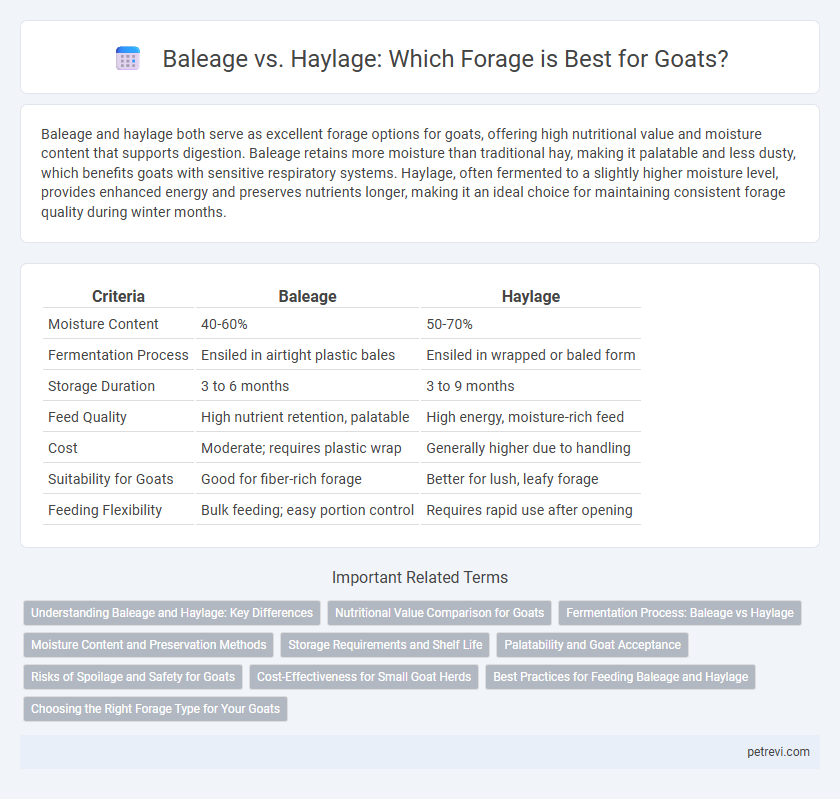Baleage and haylage both serve as excellent forage options for goats, offering high nutritional value and moisture content that supports digestion. Baleage retains more moisture than traditional hay, making it palatable and less dusty, which benefits goats with sensitive respiratory systems. Haylage, often fermented to a slightly higher moisture level, provides enhanced energy and preserves nutrients longer, making it an ideal choice for maintaining consistent forage quality during winter months.
Table of Comparison
| Criteria | Baleage | Haylage |
|---|---|---|
| Moisture Content | 40-60% | 50-70% |
| Fermentation Process | Ensiled in airtight plastic bales | Ensiled in wrapped or baled form |
| Storage Duration | 3 to 6 months | 3 to 9 months |
| Feed Quality | High nutrient retention, palatable | High energy, moisture-rich feed |
| Cost | Moderate; requires plastic wrap | Generally higher due to handling |
| Suitability for Goats | Good for fiber-rich forage | Better for lush, leafy forage |
| Feeding Flexibility | Bulk feeding; easy portion control | Requires rapid use after opening |
Understanding Baleage and Haylage: Key Differences
Baleage and haylage are both fermented forage options that provide high moisture content and improved palatability for goats, but they differ primarily in moisture levels and wrapping techniques. Baleage typically contains 40-60% moisture and is wrapped in plastic to create an anaerobic environment essential for proper fermentation, while haylage has a slightly lower moisture content of around 50-60% and is often ensiled in silos or bags. Understanding these differences helps optimize goat nutrition by selecting the appropriate forage based on storage needs, climate conditions, and the specific dietary requirements of the herd.
Nutritional Value Comparison for Goats
Baleage and haylage are both fermented forage options that provide goats with high moisture content and enhanced digestibility, but baleage typically contains higher fiber and lower carbohydrate levels compared to haylage. Haylage offers greater energy density and more readily available nutrients due to its earlier harvest and fermentation process, which benefits lactating and growing goats requiring higher nutritional intake. Comparing crude protein levels, baleage often retains slightly more protein, making it a preferable choice for maintenance and dry goats, whereas haylage supports production-intensive phases.
Fermentation Process: Baleage vs Haylage
Baleage and haylage both undergo anaerobic fermentation that preserves moisture and nutrients, but baleage typically has a higher dry matter content (40-60%) compared to haylage (50-70%), affecting fermentation speed and microbial activity. The fermentation process in baleage is dominated by lactic acid bacteria that lower pH to preserve forage quality, while haylage often achieves a more stable fermentation due to its slightly higher dry matter, reducing the risk of undesirable microbial growth. For goat forage, optimal fermentation ensures nutrient retention and digestibility, making baleage suitable for higher-moisture feeds and haylage preferable when longer storage with minimal spoilage is required.
Moisture Content and Preservation Methods
Baleage typically contains 40-60% moisture content, making it more prone to fermentation and requiring airtight wrapping to preserve nutritional quality for goats. Haylage usually has a slightly lower moisture level, around 50-60%, and relies on controlled anaerobic fermentation to maintain feed quality and prevent spoilage. Proper preservation methods for both baleage and haylage are essential to minimize mold growth and ensure optimal digestibility and nutrient retention in goat forage.
Storage Requirements and Shelf Life
Baleage requires airtight, moisture-proof wrapping to prevent spoilage and typically lasts 3 to 6 months when stored properly. Haylage demands similar sealed conditions but generally offers a longer shelf life of up to 9 months due to its lower moisture content. Proper storage in controlled environments reduces mold growth and preserves nutrient quality essential for goat forage.
Palatability and Goat Acceptance
Baleage offers higher palatability for goats due to its moist texture and slightly fermented flavor, which encourages better intake compared to haylage. Goats typically prefer baleage because its softer consistency closely mimics fresh forage, enhancing chewability and nutrient assimilation. Haylage, while nutrient-dense, may have lower acceptance rates among goats due to its denser fermentation and less desirable taste profile.
Risks of Spoilage and Safety for Goats
Baleage and haylage both provide moisture-rich forage options for goats, but baleage typically has higher moisture content, increasing the risk of spoilage from mold and harmful mycotoxins. Haylage offers improved fermentation control and lower spoilage risk, yet improper storage or inadequate drying can still pose safety hazards, leading to digestive issues or poisoning in goats. Ensuring optimal moisture levels and airtight storage conditions is crucial to minimize spoilage and maintain safe, nutritious forage for goat health.
Cost-Effectiveness for Small Goat Herds
Baleage offers a cost-effective forage option for small goat herds by preserving moisture and nutrients without the higher equipment investment required for haylage production. Haylage demands specialized wrapping machinery and storage conditions, which can increase upfront costs and complexity for small-scale producers. Choosing baleage reduces overall expenses while still providing high-quality forage that supports goat health and productivity.
Best Practices for Feeding Baleage and Haylage
Feeding baleage and haylage to goats requires attention to moisture content and fermentation quality to prevent mold and spoilage, ensuring optimal nutrition and palatability. Baleage typically contains 40-60% moisture, while haylage has 50-70%, and both should be stored airtight to maintain anaerobic conditions that preserve nutrient density and minimize harmful bacteria growth. Regularly inspecting forage for spoilage, introducing it gradually to goats' diet, and supplementing with minerals can enhance digestion and overall goat health.
Choosing the Right Forage Type for Your Goats
Baleage offers higher moisture content and improved palatability, making it ideal for goats needing easily digestible forage with enhanced nutrient retention. Haylage provides a more consistent fiber-to-moisture ratio, supporting rumen health and efficient nutrient absorption in goats. Selecting the right forage type depends on the goats' age, health status, and forage storage conditions, ensuring optimal growth and productivity.
Baleage vs Haylage for Goat Forage Infographic

 petrevi.com
petrevi.com